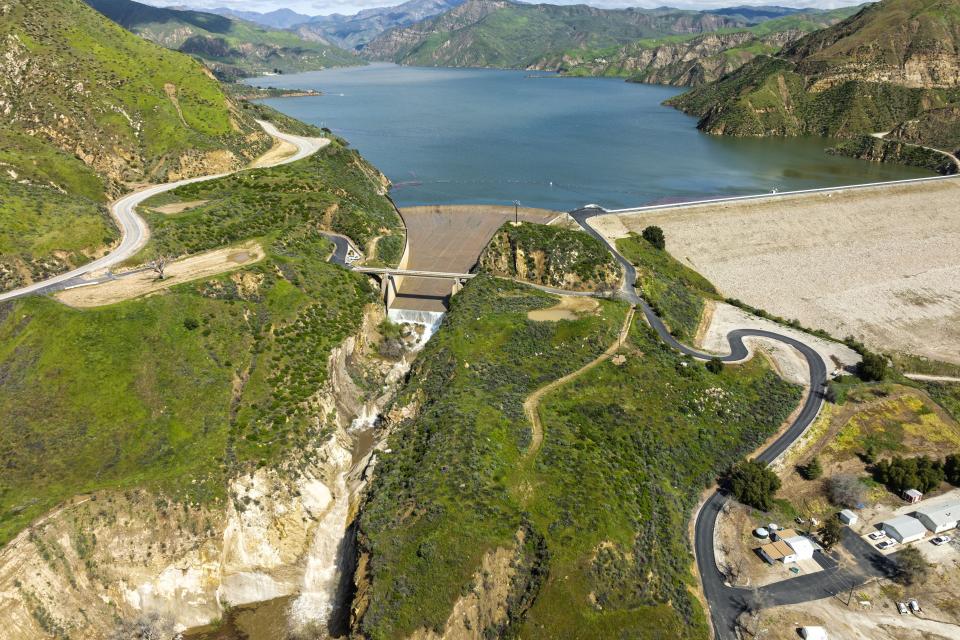Lake Casitas crept closer to spilling this week, marking what would be a first for the drought-stressed reservoir in more than 25 years.
The Ojai Valley lake was over 96% full as of Tuesday. When the water will reach the spillway remains to be seen. Mike Flood, general manager of the Casitas Municipal Water District, said it could be as soon as next week.
The lake last spilled in 1998. It came close again in 2005, but the district stopped diverting water from the Ventura River to slow things down during a damaging storm season.
Since then, the lake level dropped to record lows during a yearslong drought. Casitas, which gets no imported water, fell below half full in 2015 for the first time since it had filled decades earlier. Water levels kept falling. District officials were looking at severe water restrictions in 2022.
Back then, most would not have expected the turnaround that happened over the past two years, said Mary Bergen, a Casitas board member. But the history of California has been one of floods and droughts.
“We have to deal with both,” she said. “We have to be prepared for both.”
When did Lake Casitas first spill?
The lake, which provides drinking water for the Ojai Valley and parts of Ventura, bounced back as last year’s storms pushed the water level over 50% and then 70% capacity. For the first time in years, residents weren’t required to curb their water use or risk fines.
Now, a second wet winter has edged it closer to full. At capacity, the reservoir is designed to hold enough water to make it through a 20-year drought, officials said.
Bergen called the nearly full lake a beautiful sight.
“It is wonderful to see the lake up and have a good water supply,” she said.
Lake Casitas was OK’d by federal officials in 1956 and construction on the dam was completed a few years later. It took more than a decade before the lake filled, slowly covering old ranches, roads and a school. Since, the spillway has operated eight times from 1978 to 1998.
What happens if Lake Casitas spills?
Water could reach the spillway in the next seven to 10 days, Flood said Tuesday. Without a major storm, the volume of the flow is expected to be relatively low.
The district also would shut off diversions from the Robles facility as water reaches the spillway, Flood said. Roughly 30 to 40% of the flow into the lake comes from the diversion facility. Additional water comes from Coyote Creek and Santa Ana Creek.
The spillway, designed to keep water from overtopping the dam, funnels the excess into Coyote Creek.
During last year’s storms, mud and debris built up along a stretch of the creek downstream of the dam near Camp Chaffee Road. The problem led to flooding in the Foster Park neighborhood and left less room for additional flows. Plans call for clearing sediment later this year.
Authorities will continue to monitor conditions, said Patrick Maynard, director of the Ventura County Sheriff’s Office of Emergency Services. Spilling during high intensity rainfall may be a concern, but low volumes likely won’t cause issues, he said.
“It is something we are just going to need to watch,” he said.
How close is Lake Piru from spilling?

Over the past month, the smaller Lake Piru also inched toward its capacity, pushing the eastern Ventura County reservoir close to spilling.
Last March, water breached the Santa Felicia Dam’s spillway for the first time in nearly two decades. Since, it has teetered close to doing it again. Earlier this year, officials at the United Water Conservation District said a spill in back-to-back years has only happened three times since the dam was constructed in the 1950s.
Several big storms had pushed water levels up to the lip of the spillway last year. But this winter, there were more gaps in between the rainfall, United’s Chief Engineer Maryam Bral said. The lake levels stayed below that mark.
Instead, the district has released water into lower Piru Creek through a system of pipes and valves over the past several weeks, she said. Late last year, United also released some water to create additional storage and let areas downstream recharge. The lake was around 40% full heading into the winter storms, officials have said.
Cheri Carlson covers the environment and county government for the Ventura County Star. Reach her at [email protected] or 805-437-0260.
This article originally appeared on Ventura County Star: Dams inch closer to spilling in Ventura County, California
Source Agencies


